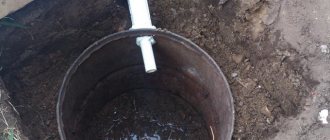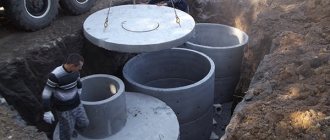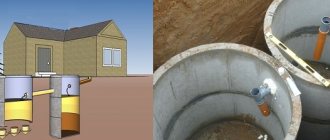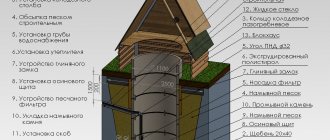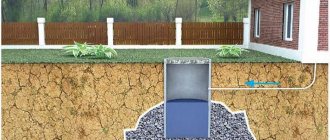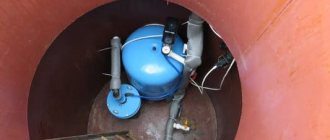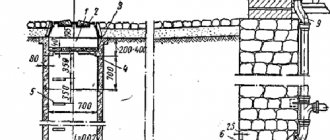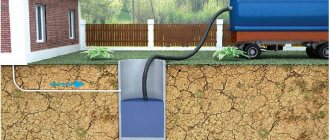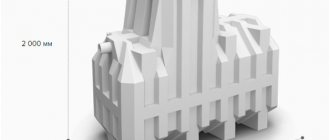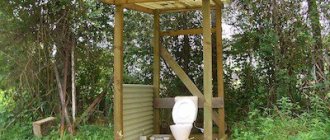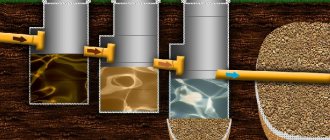Few people are satisfied with the dubious comfort of an ordinary cesspool today. The need to often call vacuum cleaners with constant use is far from the only drawback. Septic tank sewerage is becoming increasingly popular - what it is should be considered in more detail. To summarize, we can say that such a system provides for the possibility of recycling waste. As a result, the degree of comfort increases and the risk of unpleasant situations occurs - the appearance of odors, the penetration of harmful substances into the soil, etc.
What is a septic tank
A septic tank is a more complex sewerage structure, consisting of a sealed container, sometimes with several filter wells for absorbing purified water into the ground.
Making a septic tank for your home with your own hands is quite easy. Septic tanks are quite good at breaking down pollutants into simpler ones, followed by filtration. Therefore, there is no environmental pollution with wastewater.
Types of septic tanks
To ensure a comfortable stay in a private household, you should take care of the sewer system. Therefore, the developer is faced with the problem of selecting a septic tank for his site.
Reservoirs are classified according to design, principle of operation, and material. The following types of devices are distinguished:
- accumulative;
- anaerobic;
- aerobic.
The storage option consists of a container into which wastewater flows. They settle in it, and then they are pumped out. You can do this option yourself. It is characterized by its low price, ease of installation, autonomy, and is suitable for areas where groundwater is located high.
This option also has some disadvantages: periodic pumping of wastewater is required, there is an unpleasant odor, and the volume is small.
The anaerobic type is a sealed structure in which microbiological decomposition of organic matter occurs without access to oxygen. The installation consists of several parts. The model is supplemented with aerobic fields.
If there is a lack of microbes in the device, then their number is increased by introducing special preparations into the system. This type of septic tank is popular among private developers, as it is highly efficient and affordable. It does not require electricity to function.
Aerobic type ensures water purification by 98%. Such devices use special bacteria that can completely decompose waste. This model is the most expensive type, it provides high cleaning efficiency.
To choose a good septic tank, you need to accurately calculate how much tank volume is required. The intensity of use of the tank and the cost of the system should be taken into account.
This equipment can be factory-made or home-made; you can purchase a volatile or autonomous type. There are underground and above-ground structures; the model may require pumping.
Purpose of septic tanks
A septic tank is designed to collect pollutants and then decompose them into simple substances. Purified water is absorbed into the soil. Thus, septic tanks prevent wastewater from polluting the environment.
Of course, septic tanks cannot completely purify water. Alkalis, drugs, acids remain in the water.
Choosing a septic tank for a summer residence: how to calculate the volume
According to sanitary standards, one person uses about 200 liters of water per day. The same amount will go down the drain. The wastewater must remain in the first storage section for at least three days, so the minimum septic tank designed for one person must hold 600 liters. Now you need to multiply this figure by the number of people and round up.
For example, three people live in a house, which means the total volume of wastewater will be 1.8 m³, which means the volume of the septic tank must be at least 2 m³. In this case, the first section should account for 2/3 of the total volume. For a three-chamber septic tank, the remaining volume is divided equally into the remaining sections.
Selection of bacteria
A septic tank cannot operate without bacteria. After all, only bacteria perform the main role in decomposing pollutants. Sewage bacteria are divided into two types: aerobic (cannot live without oxygen) and anaerobic (putrefactive).
Anaerobic bacteria live in almost any conditions, unlike aerobic bacteria, which die when there is a lack of oxygen.
But anaerobic bacteria have one big disadvantage: the products of their activity contain solid deposits and produce methane, which contributes to an unpleasant odor. But they do not need pit ventilation. And aerobic bacteria are released into septic tanks for both homes and cottages.
Which bacteria to use is up to you.
General principle of operation and nuances
In septic tanks, wastewater treatment occurs in stages.
- In the first chamber, preliminary sedimentation of impurities and separation of wastewater into light and heavy fractions occurs.
- The second chamber, like the first, is a place of active work of anaerobic bacteria, decomposing the organic matter remaining after the first chamber and turning it into a sludge mass. This decomposition has a number of advantages. Firstly, it eliminates the occurrence of putrefactive processes with the formation of a strong unpleasant odor. Secondly, the resulting sludge occupies a smaller volume, so the septic tank has to be cleaned much less frequently than a regular cesspool.
- In the third chamber, the remaining particles of inclusions are also deposited on the bottom (if the liquid is drained into a filtration field) or on the filter backfill (gravel, crushed stone, etc.) in chambers without a sealed bottom.
The first two chambers of the septic tank have a sealed bottom, and the bottom of the third chamber made of gravel allows waste to flow into the ground.
Liquid flows from chamber to chamber through holes in the upper part of each tank. This allows purified water from the upper layers to be delivered to each subsequent container.
Septic tank made from car tires
A septic tank made from car tires is one of the cheapest options both in terms of construction cost and maintenance. Finding old tires is quite easy.
- Do-it-yourself windmill - the best ideas and instructions for building decorative windmills in the garden and on the site (105 photos)
Do-it-yourself walk-behind tractor - how to make a simple and reliable homemade walk-behind tractor for farming (105 photos)
Grafting an apple tree: how and when correctly, grafting methods
For construction you will need to dig two pits. Place car tires in them, on top of each other. Fasten the tires together with clamps and seal the seams. In one pit, cover the bottom with polyethylene (waterproofing), in another with fine crushed stone or sand.
Disadvantages of this design:
- fragility, sealed seams begin to leak liquid.
- in winter it is inoperable because it freezes.
What types of septic tanks are there, their descriptions
For a more comfortable stay at the dacha, there are two types of septic tanks: storage and purification.
Storage containers are simple containers that are designed to store waste. This container is made from different materials and different sizes.
IMPORTANT! A storage septic tank with sewage waste can be located both underground and above ground.
This septic tank is similar to a cesspool; as soon as the tank is filled, it must be cleaned. Why do sludge suckers exist? A storage septic tank is great for a minimum number of people who are rarely at the dacha. Because calling a waste disposal truck costs money, and if the family is large and permanently living at the countryside, then it will be completely unprofitable. And there is no way to do this without pumping. The price for such a septic tank is low, and you can do the installation work yourself.
Purification - such septic tanks ultimately clean the drain. The cost of choosing such a septic tank will vary, since there is a different level of cleaning, tank capacity, operating principle, as well as the availability of additional functions.
In order to thoroughly clean the wastewater (98%) and carry out disinfection, a biological treatment station will be required.
IMPORTANT! Compact biological treatment station, lightweight and easy to install and maintain. The station contains several chambers into which wastewater flows alternately. In each of the chambers a certain process is carried out, which ultimately makes it possible to obtain a clean liquid.
IMPORTANT! The smell of the resulting liquid, when processed by a biological treatment station, is similar to the smell of a clean river. Such water will be absolutely safe for watering your dacha.
It’s cheaper to make a septic tank for your dacha yourself, but you will spend a lot of effort and time, so summer residents often choose factory-made septic tank models with turnkey installation.
Purchased septic tanks may or may not depend on electricity. Therefore, when choosing, you need to be careful and take this factor into account, especially if your dacha does not have electricity or there are frequent failures.
Septic tank from euro cubes
You will need two or three euro cubes. The bottom is cut out in one (for filtration), the others are left sealed.
They dig a trench (necessarily at a slope so that the first cube is higher than the next one), fill it with cement to fix the cubes. Afterwards, Euro cubes are installed, tying pipes together and fixing them to the ground. The pipe/cube connections are coated with sealants.
Septic tanks made from Euro cubes are easy to install, sealed and last a long time. But they need to be secured to the ground, otherwise they may be squeezed out of the ground.
Materials for septic tank
Plastic tanks are lightweight, durable and easy to install. If installed correctly, the product can last for half a century. To install a small septic tank, you do not need special equipment.
Such models are not suitable for areas where there is a high groundwater level. A lightweight structure can be prevented from floating to the surface if it is concreted or secured with special straps.
If you are interested in how to make a septic tank, pay attention to concrete structures. This type will be a good solution for a summer house. A septic tank made of concrete has high strength and is not afraid of corrosion. It is heavy.
You can purchase ready-made rings, but you will have to hire special equipment to install them. To save money, concrete is poured by hand.
You can use a metal septic tank to drain domestic wastewater. It is popular among private property owners due to its affordable price. This product is susceptible to corrosion. Metal containers are often used for areas with high groundwater levels.
If you plan to live at the dacha only in the summer, then you can make a simple tank with your own hands. For this, improvised means can be used: car tires, plastic barrels.
It will not be possible to make the structure airtight, so it is not suitable for cleaning toilet drains. This option is used for a country shower.
Brick construction
When building a septic tank from brick, it is important to use clinker bricks. Any others crumble from moisture.
A pit is being dug in which a pool is laid with bricks. Next, we insulate the bottom and inner walls of the pool with a cement mixture. We insulate the outer walls with clay. The thickness of the clay layer is at least 0.2 meters.
The rest of the work is the same as in any other construction method.
Pickling cabbage in jars for the winter: proven recipes - unusually crispy!- DIY garden figures - features of application, lighting and decoration (80 photos)
- DIY swings - the best ideas and options for making a homemade swing (130 photos)
How to choose a place for a septic tank in your country house?
When choosing a location for a treatment plant, you must follow several rules:
- the distance to the foundation of a residential building must be at least 5 meters;
- from the well - 50 meters;
- from the reservoir – 30 meters;
- from trees – 3 meters;
if the site is on a slope, the septic tank should be located below the level of the house and well.
Failure to follow these rules can result in wastewater entering your water supply and contaminating your drinking water with harmful bacteria.
Exploitation
It's one thing to build a sewer system. The other is to operate correctly so that the system functions at a sufficient level.
So, let's look at how to maintain and operate a septic tank:
- Waste must be drained regularly to ensure bacterial life.
- It is prohibited to drain caustic chemicals (acids, alkalis, petroleum fluids, surfactants, etc.)
- It is necessary to periodically clean out bacterial waste products (silt deposits)
- Do not dump household waste.
If all requirements are met, such a sewer system will serve you for decades.
Septic tanks for a summer residence: which one is better
The market offers many ready-made models for local wastewater treatment systems. Based on customer reviews and sales volumes, you can make a rating of factory-made septic tanks. The following models are considered the best in quality and optimal in price:
- a plastic septic tank of six chambers with an Ecopan biofilter is designed for 6-8 people;
- installation of two tanks with a “Breeze” biofilter. Designed for 3-5 people who constantly use water;
- modular septic tank "Count" is available with one, two or three sections;
- The Astra cleaning system is designed to collect and process wastewater from several private houses at once.
Without a doubt, the best septic tanks without pumping are industrial designs, where all the details are thought out by specialists, and the manufacturers guarantee absolute tightness and a high degree of purification. However, a simple septic tank for a country house, made with your own hands in compliance with all precautions, will always be a good and economical alternative to a factory one.
Photos of septic tanks with your own hands
Installation step by step
Let us describe in detail the process of making a septic tank for a house from concrete rings. The number of chamber sections does not matter much - only the volume of the septic tank and the correct location of the drains are important.
Pit preparation
Construction of a pit for concrete rings
Each container will require a separate pit.
They can be placed along one line or arranged in the form of a triangle:
1 Concrete tanks must be installed above the groundwater level . In this case, the drain pipes must be located deeper than the freezing point (this indicator is different for different regions of Russia). In the Moscow region, this figure is 1.4 m. When they are located horizontally above the specified level, additional insulation is required.
2 Work should begin in the hot period of the year so that the groundwater drops to its lowest point . Otherwise, the installed containers may simply float.
3 For ease of installation, make the width of the pit slightly larger than the dimensions of the container. For a concrete ring 1 m wide, a margin of 20-30 cm is required.
4 To avoid soil pressure on the container, a layer of gravel is poured into the bottom of the hole . In the absence of such a cushion, the tank may become deformed or move.
Pipeline laying
Containers must be equipped with a sanitary tee
1For sewer pipelines, corrugated polyethylene products are used that are sufficiently resistant to deformation and can withstand significant temperature changes. Please note that such pipes are orange and marked SN 8. They are more rigid and consist of several layers. Gray or white SN 4 pipes are not suitable for indoor installation - they can simply be crushed under the weight of the soil.
2Pipes must be laid in concrete trays with the trench backfilled with sand.
3To ensure free flow of waste into containers, pipes are laid at an angle. With their diameter of 110 mm, it should be equal to 2 cm for every meter. With a diameter of 160 mm, the slope will be 1.5 cm for each meter. A larger slope angle is not required, otherwise the pipes will become clogged.
4Pipes leading into receiving tanks must have tee fittings at the end, open at the top and bottom. In this case, the flow of liquid will be redirected correctly, and debris and grease film floating on top will not overflow. The lower outlet is intended for sampling the lower layers of liquid, and the upper one is for cleaning.
5For proper functioning of the system, the overflow pipes must be located below the layer of fatty film, but not higher than the settling layer, which collects at the bottom in the form of sludge and must be periodically pumped out.
6When laying, try to avoid turns. If you can’t do without them, be sure to install inspection wells in such places for cleaning.
Installation of concrete rings
Rings for filter well
1The most common do-it-yourself septic tanks for private houses are containers made of concrete rings. You can also use structures made of monolithic concrete, but it will take much more time to erect them, install formwork and pour concrete, and the cost will not be much cheaper.
2Concrete rings are lowered into the prepared pit using machinery or manually.
3The lower ring of the first settling tank must have a concreted bottom. If it is not possible to purchase such a structure, you can concrete the bottom of the pit itself, and when installing the ring, carefully seal the joint.
4For a filter well (more about it below) you will need to purchase rings with 30-50 mm perforation. If the filtration capacity of the soil is good, you can also use a regular non-perforated ring without a bottom.
5In the upper part of the septic tank, rings are installed, equipped with holes for the inspection hatch.
6To protect the rings from displacement, they are fastened together using metal plates.
7To prevent wastewater from getting into the ground, when laying concrete rings, their joints are carefully sealed using bitumen or modern sealants, for example, bastion.
8To ensure oxygen deficiency (anaerobic bacteria are able to work only in such conditions), water seals and blockers are installed at the inlet and outlet of the second chamber. For such bacteria to work, a temperature of 10-35°C is also required, so septic tanks installed above the soil freezing level additionally insulate them
.
9After connecting the pipeline, the container is filled with expanded clay or sand. This will allow you to better regulate the temperature inside the treatment system.
10 Adequate ventilation must be provided to remove the explosive methane gas produced by bacteria digesting waste. For this purpose, risers are used, which are located 70 cm from the soil surface. To prevent odors from spreading throughout the entire territory of the site, it is better to raise them above the roof of the building to a height of 0.3 m. You should not make the pipe too high, otherwise it will freeze.
Scheme for manufacturing a septic tank for a private house with mandatory ventilation
In clay areas, the installation of septic tanks and their soil purification is impossible. Most often, groundwater rises high in such places. In these cases, it is necessary to use completely sealed plastic or steel products or install expensive aeration deep cleaning units.
General information about autonomous sewerage
The direct purpose of a septic tank is to accumulate wastewater. After filling, the contents must be pumped out and removed, then the cycle repeats.
A septic tank, being a storage tank, is part of an autonomous sewer system, which also consists of an internal and external pipeline.
In advanced houses, additional containers, infiltrators and filtration fields are used.
The most productive systems have chambers with bacteria inside, which help process waste into peat and remove harmful substances such as ammonia from waters.
Structure of a biological treatment septic tank
For such systems, a large list of materials is used, the properties of which determine the characteristics of the entire system.
Drainage field
The main disadvantages of such structures include the presence of free space on the site for laying drainage pipes and a long level of purification - for complete filtration such a field must have a significant extent.
Therefore, it makes sense to construct drainage fields in cases where, with a high rise in groundwater (up to 2.5 m), the construction of deep filtration wells becomes impossible.
Drainage field
The size of the drainage field and the number of trenches laid depends on the volume of the septic tank. For 1 meter of pipes laid per day there should be up to 30 liters of purified water. For sandy loam soils that can absorb less liquid, this parameter is reduced to 15 liters. For loams it will be even smaller - the length of the pipes will have to be increased.
The diameter of the perforated pipes is 11 cm. In order for the liquid to be evenly distributed over the area, the distance between the pipes should be 1.5 m. Their length should be maintained no more than 20 m. Each of them is equipped with a ventilation riser, which should rise above the ground by 0. 5 m.
In order for the liquid to flow freely into the ground, the pipes are laid with a slope of 2 cm per linear meter. The average depth of the trench is 2 m. It must be taken into account that its bottom should be at a distance of 1 m from the groundwater level. When laying pipes at shallow depths, they will require additional insulation.
A layer of soil 10 cm high with good filtering capacity is first poured into the bottom of the prepared pit. On clay soils its height should be increased to 70 cm.
Next comes a 35-40 cm layer of crushed stone, into which perforated pipes are laid. Another 10-centimeter layer of crushed stone is poured on top, geotextiles and a 30-centimeter layer of soil are laid.
Septic tanks: Types and photos
Photo
A septic tank is an element of a local treatment plant. Used for cleaning domestic wastewater. First, the water enters the container, where it undergoes a purification stage under the influence of bacteria, then it is drained into the sewer. Some modern septic tanks are capable of purifying water by 95-98%. This level of cleaning ensures that there is no damage to the environment of your home garden.
It is advisable to install septic tanks in those areas that are not connected to the central (city sewerage) system.
Recommendations for use
3-chamber system
With proper installation, septic tank maintenance is reduced to a minimum:
- for the smooth functioning of the system, care should be taken to ensure that petroleum products, solvents, household poisons, alkalis, alcohol and other aggressive chemicals that can destroy anaerobic bacteria do not get into it; Clogging of the septic tank is also facilitated by the entry into the sewer of construction waste and inorganic residues that cannot be decomposed.
- with proper operation, thick sludge will have to be pumped out infrequently - once every 2-3 years; It is necessary to call a vacuum cleaner if it rises closer to the surface by 20 cm
- It is necessary to pump out the septic tank not completely, leaving 10-20% so that anaerobic bacteria, that is, “ferment”, are preserved at its bottom
- To maintain the vital activity of bacteria, the constant presence of organic substances is required, therefore, in garden plots not used for permanent residence, it is better to equip not a septic tank, but an ordinary cesspool
VIDEO: The simplest and most effective septic tank (explanation and diagram).
Septic tank for a home - sewer pit without pumping: device, step-by-step DIY production from concrete rings and other options (15 Photos & Videos)
